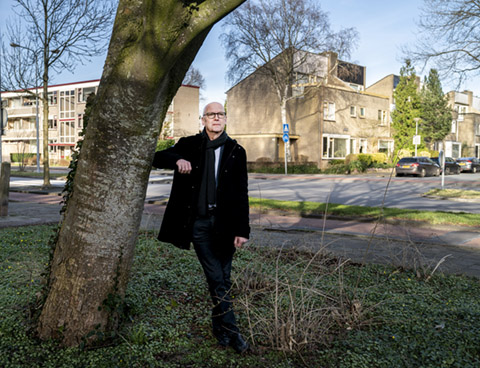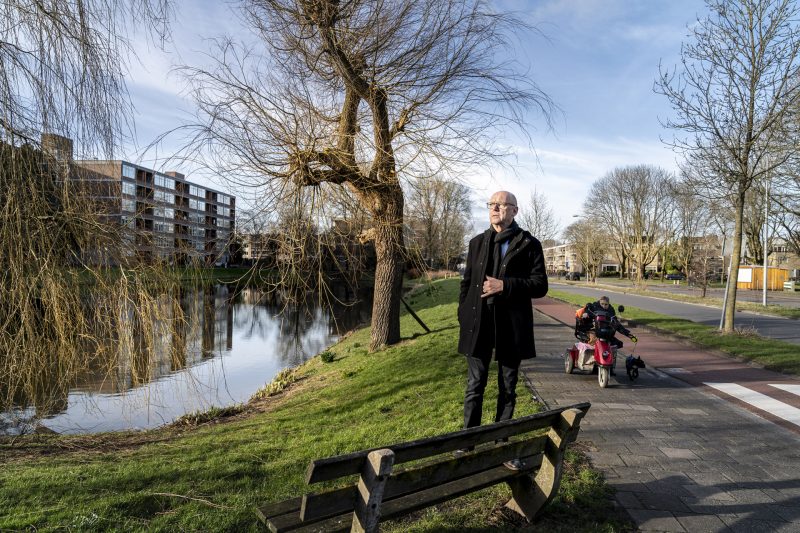
Paddepoel 2.0
Down with
suburbia
Are people healthier in Manhattan, the city centre of New York, or in the suburbs of Almere? In other words: Is it healthier to live in a busy city centre or in a green, spacious suburb? Professor of urban development and architecture Cor Wagenaar poses this question to his students quite a lot.
Eighty percent of them always say the suburbs. But in reality, it’s city centres that are healthier. This goes for Manhattan and Almere, and also for the Groningen city centre and a neighbourhood like Paddepoel.
So how does it work? It’s simple: People walk more in city centres. ‘Anyone who walks regularly will probably live up to ten years longer than someone who sits on the couch all the time.’
There are other things that make living in a city centre healthier, such as social services against loneliness, but the way people travel has the biggest effect. But suburbs are designed in such a way to discourage walking, says Wagenaar.
The dominant car
Take the neighbourhood Paddepoel, for instance. It’s from the post-war reconstruction period during which public spaces had to make way for cars. Roads became wider, central shopping centres were built, and the distance between houses and services grew.
Anyone who walks regularly will probably live up to ten years longer
‘Before cars started dominating the scene, the street was a good place to meet people’, says Wagenaar. ‘But now, children can no longer play in the street, and it’s become more difficult to have a chat with your neighbours. Because almost all neighbourhoods have been designed around cars, they’ve become completely unsuitable for pedestrians.’
Paddepoel is a typically ‘spread-out’ neighbourhood. Because of all the green spaces in between the houses and the main roads, the walking distances between places are long. ‘There’s the Zonnelaan and the Eikenlaan, and they’re not great roads to cross on foot. But the only central shopping centre is on the other side of the Zonnelaan. There aren’t enough pedestrians around for small corner shops, that people can get to on foot, to be viable.’
Zebra crossings
Time for a change, Wagenaar felt. But how could he change the neighbourhood’s design in such a way that it would improve residents’ health?
In 2018, he and partners at his Expertise Centre Architecture, Urbanism and Health began exploratory research into the possibilities. ‘We found out that especially older residents had a hard time reaching the shopping centre on foot.’ Drone footage from the Zonnelaan, among other places, revealed why. ‘The zebra crossings are in the wrong places. So instead of crossing where they should, people use the median strips. It’s a miracle there aren’t accidents all the time.’
The squares that had been created between houses also didn’t work anymore. They had once been designed for people to run into each other and have a chat, but now, they’re just bare spaces with garages where people only go when they really have to.
New parks
The research resulted in three different plans.
‘The first one comprises only very slight adjustments’, says Wagenaar. ‘We solve the issue with the zebra crossings, traffic lights, and move some benches, so residents have better access to the shopping centre.’
It’s a miracle there aren’t accidents all the time
The second plan is much more extreme. ‘We wanted to partially tear down houses and garages in the inner area and turn them into parks. It would create routes that traversed the entire neighbourhood, making walking more attractive. The Zonnelaan would become greener and less accessible to cars.’
It might sound wonderful, but Wagenaar doesn’t see it happening any time soon. ‘This option is impossible and utopian. That’s why we came up with a third option that’s halfway between the first option and this one.’

‘70 to 90 percent of public health is dependent on non-medical intervention.’ Photo by Reyer Boxem
Virtual reality
In order to test what works best, you want the residents themselves to experience what the plans would do. But the project group couldn’t just tear down the entire neighbourhood and build it anew, so now what?
‘However, we could put the newly designed parts in virtual reality’, says Wagenaar. Colleagues at the Delft Technical University did this for him, enabling Paddepoel residents to don VR glasses and walk around their ‘new’ neighbourhood. ‘Modern technology works great.’
It looked really nice, says Wagenaar. The extreme option, with houses making way for parks, does tend to make people walk more, but that doesn’t mean they prefer it. ‘People were mainly worried about losing their garage.’
This is exactly the kind of involvement he wants from residents. ‘They may not be urban developers, but they’re the end users, and that makes them the experts.’
Space for pedestrians
The final result is a plan to redesign three locations, including the Zonnelaan. He doesn’t yet know whether the plans will actually be implemented. But if the city does decide to use them, Paddepoel will have more room for pedestrians and cyclists. Cars would then start to play a much smaller role in the neighbourhood.
There has to be something for people to walk towards
But there are other ways to get people moving: installing play equipment in parks, for example, or opening more attractive stores within walking distance. Because, says Wagenaar: ‘There has to be something for people to walk towards.’
There’s hope for more stores, at least. As Wagenaar says, Paddepoel has seen an increase in high-rise flats recently. That means there are more people living in a smaller area, which in turns means an increase in customers for shops that provide healthy products, for instance.
‘The World Health Organization calculated that 70 to 90 percent of public health is dependent on non-medical intervention’, says Wagenaar. ‘That’s exactly what we’re talking about here: healthy food, social contact, and promoting exercise.’